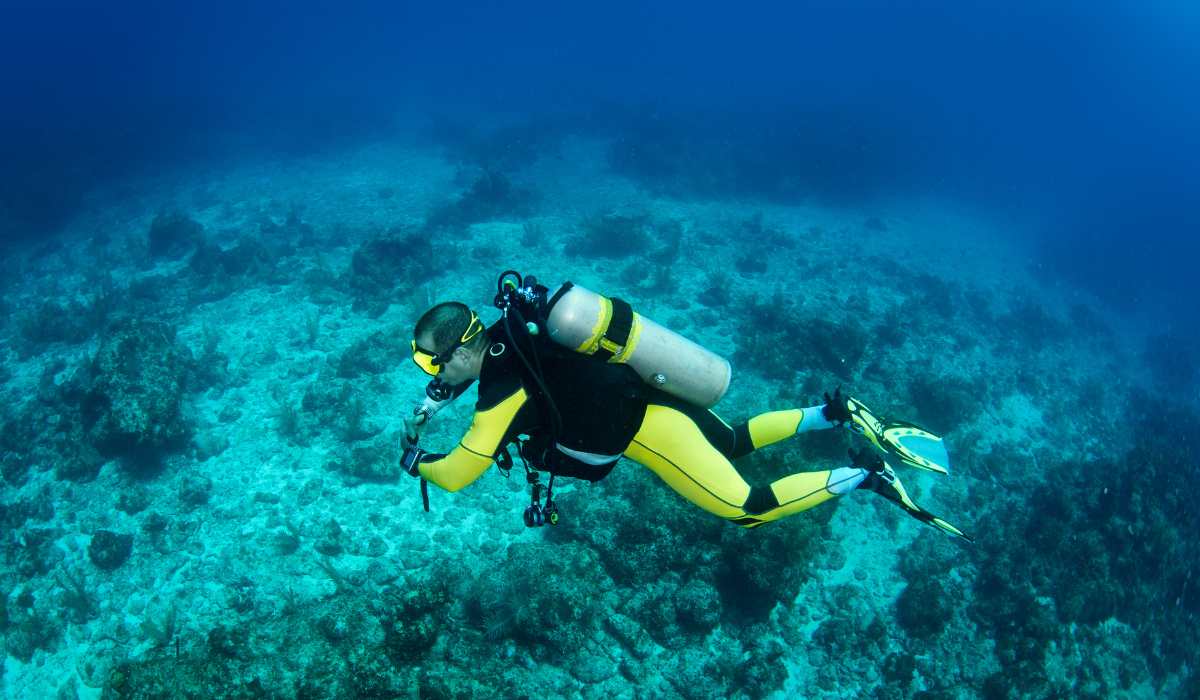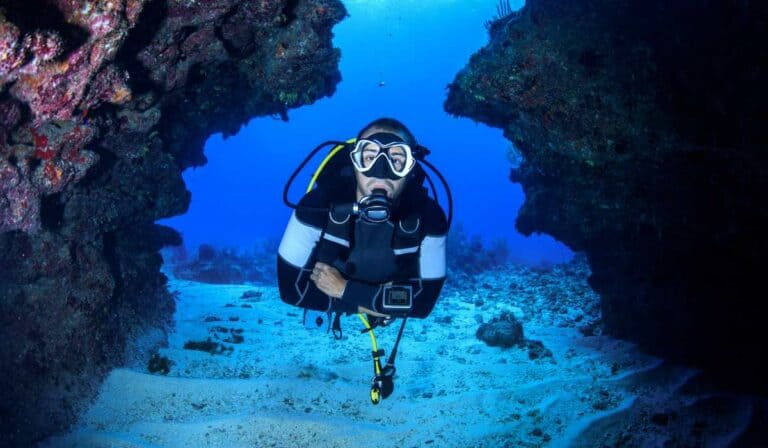World’s Best Quarries for Scuba Diving
Explore the globe’s greatest scuba diving sites and plunge into an extraordinary underwater journey. Quarry diving offers unique experiences, from submerged attractions to crystal-clear waters teeming with aquatic life. In this blog post, we’ll dive deep into the exhilarating world of quarry dives.
We will discuss the essential gear required for a successful quarry dive and introduce you to some of the top locations in the US where you can explore these hidden gems. Additionally, we will provide crucial safety tips that every diver should keep in mind while exploring these captivating sites.
Finally, learn about the numerous benefits of quarry scuba diving as compared to traditional open water dives. Ready to embark on an adventure of quarry scuba diving?
Table of Contents
1. What is Quarry Scuba Diving?

Quarry scuba diving is an exciting and unique outdoor activity that involves exploring submerged quarries filled with water. These abandoned stone or rock quarries, once used for mining purposes, have been transformed into popular dive sites for scuba enthusiasts looking to experience a different underwater environment.
The history of quarry scuba diving dates back to the 1950s when adventurous divers started exploring these flooded pits as an alternative to ocean or lake diving. Over time, quarry diving has gained popularity due to its accessibility and diverse range of attractions such as sunken artifacts, clear waters, and abundant marine life.
A Unique Underwater Experience
Diving in a quarry offers a completely different experience compared to traditional open-water dives. The enclosed nature of quarries often results in clearer visibility due to reduced currents and limited external influences on water quality. This makes it easier for divers to observe fascinating geological formations up close while also encountering various fish species that have made their homes in these aquatic environments.
Freshwater vs Saltwater Quarries
While most people associate scuba diving with saltwater locations like oceans or seas, many quarries are actually freshwater bodies formed by rainwater filling the excavated areas over time. Freshwater quarries offer some advantages over saltwater ones: they generally require less buoyancy control adjustments since there’s no need to compensate for the extra lift provided by salty water; moreover, freshwater environments tend not only to be gentler on your gear but also provide unique opportunities for observing native flora and fauna which differ significantly from those found within marine ecosystems.
Comparing Quarry Diving with Ocean Diving
While quarry diving may not offer the same level of excitement as exploring a coral reef or shipwreck in the ocean, it does provide some unique benefits. For instance, quarries are typically more accessible than remote dive sites and can be found all across the United States. Additionally, they often have controlled entry points and well-maintained facilities that make them ideal for beginners looking to gain experience before venturing into open water.
Quarry Diving Destinations
There is no shortage of amazing quarry scuba diving locations throughout the US. From Dutch Springs in Pennsylvania to Haigh Quarry in Illinois, these underwater playgrounds cater to divers of all skill levels with attractions such as submerged vehicles, training platforms, and even underwater sculptures waiting to be discovered.
Intrigued by this thrilling outdoor activity? Keep reading our blog post on SunWaterDirt.com where we’ll discuss essential gear for quarry diving and reveal some of the best locations in the United States for your next adventure.
Diving into quarries presents an exhilarating and one-of-a-kind opportunity to investigate the ocean depths, giving you a remarkable experience. With the right gear, you can dive safely into these incredible underwater worlds and make some unforgettable memories.
Key Takeaway:
Quarry scuba diving is an exciting activity that involves exploring submerged quarries filled with water, offering a unique underwater experience. Freshwater quarries offer some advantages over saltwater ones and are ideal for beginners looking to gain experience before venturing into open water. There are amazing quarry scuba diving locations throughout the US catering to divers of all skill levels with attractions such as submerged vehicles, training platforms, and even underwater sculptures waiting to be discovered.
Click here to read about Jamaica Scuba Diving Guide: Dive into the Best Underwater World
2. Gear for Quarry Scuba Diving
Before setting out on your quarry scuba journey, it is essential to be equipped with the correct apparatus in order to guarantee a secure and gratifying experience. The equipment needed for quarry diving is similar to that used in open water scuba diving, with some additional items specific to the unique environment of quarries.
A. Basic Scuba Gear
- Wetsuit or Drysuit: Quarries can have colder water temperatures than other dive sites, so wearing an appropriate wetsuit or drysuit is crucial for thermal protection. Check out this guide on wetsuits vs drysuits.
- Buoyancy Control Device (BCD): A BCD helps maintain neutral buoyancy underwater and holds your tank securely in place.
- Tank and Regulator: Your air supply comes from a tank strapped onto your back, connected through a regulator that delivers breathable air at ambient pressure.
- Fins: Fins provide propulsion while swimming underwater, allowing you to move efficiently without expending too much energy.
- Masks and Snorkels: Masks help you see clearly underwater by creating airspace around your eyes while snorkels allow breathing at the surface without lifting your head out of the water entirely.
B. Additional Quarry-Specific Gear
- Hood & Gloves: In addition to full-body exposure protection like wetsuits or drysuits, hoods & gloves are recommended due to colder temperatures and possible sharp edges in quarries.
- Underwater Light: Quarries can have lower visibility than open water dive sites, so carrying an underwater light is essential for better illumination. Check out our list of best underwater lights.
- Dive Computer: A dive computer tracks your depth, time spent underwater, and other crucial information to help you stay within safe limits during your quarry scuba diving experience.
In addition to the gear mentioned above, always remember to carry a surface marker buoy (SMB) and whistle or signaling device for safety purposes. It’s also wise to invest in quality gear from reputable brands like Scubapro, Aqua Lung, or Mares. Properly fitting equipment will ensure comfort and prevent any unnecessary accidents while exploring the depths of these fascinating quarries.
Having the right gear for quarry scuba diving is essential to ensure a safe and enjoyable experience. Let’s check out some of the top spots for quarry scuba diving across America.
Key Takeaway:
Before embarking on a quarry scuba diving adventure, it’s crucial to have the right gear. In addition to basic scuba gear like wetsuits and tanks, specific items such as hoods & gloves, underwater lights, and dive computers are recommended for better safety and visibility in quarries. Always invest in quality equipment from reputable brands for comfort and accident prevention while exploring these fascinating sites.
3. Best Locations for Quarry Scuba Diving in the US

If you’re looking to explore some of the best quarry diving spots in the United States, we’ve got you covered. These locations offer unique underwater experiences that will leave you with unforgettable memories.
- Mead’s Quarry – Knoxville, Tennessee: Located within Ijams Nature Center, Mead’s Quarry offers clear waters and an abundance of aquatic life. The site features a sunken airplane fuselage and other submerged structures waiting to be explored by divers.
- Dutch Springs – Bethlehem, Pennsylvania: This former limestone quarry is now a popular spot for scuba diving enthusiasts thanks to its crystal-clear water and variety of attractions such as vehicles, aircraft, and even a fire truck. Visit their official website at Dutch Springs.
- Morrison Springs – Ponce de Leon, Florida: Known for its stunning natural beauty and diverse marine life, Morrison Springs is one of Florida’s most famous freshwater dive sites. With depths reaching up to 300 feet (91 meters), this location provides thrilling opportunities for both novice and experienced divers alike.
- Bonne Terre Mine – Bonne Terre, Missouri: Dive into history at this massive flooded mine filled with fascinating artifacts from its mining days including tools and machinery still visible today. Rated as one of America’s top ten greatest adventures by National Geographic, Bonne Terre Mine offers guided dives for all skill levels. Check out their website at BonneTerreMine.com to plan your visit.
- Mystery Lake Scuba Park – Wendell, North Carolina: This former rock quarry turned scuba park is home to a variety of fish species and submerged structures such as boats and planes that make it an exciting diving destination.
No matter which location you choose, these quarry dives offer unique underwater experiences that will surely leave you wanting more. So gear up and get ready to explore some of the best quarry diving spots in the United States.
Exploring the US’s natural beauty via quarry scuba diving can be a thrilling experience, but it is essential to adhere to safety guidelines in order to avoid potential hazards. To ensure that your quarry scuba diving adventure goes smoothly, make sure to review the essential safety tips outlined in our next heading.
Key Takeaway:
The article highlights some of the best quarry diving spots in the United States, including Mead’s Quarry in Knoxville, Dutch Springs in Pennsylvania, Morrison Springs in Florida, Bonne Terre Mine in Missouri, and Mystery Lake Scuba Park in North Carolina. These locations offer unique underwater experiences with an abundance of aquatic life and submerged structures waiting to be explored by divers.
Click here to read about Is Scuba Diving Dangerous? Exploring Risks and Safety Tips
4. Safety Tips for Quarry Scuba Diving
Quarry diving can be an exhilarating experience, but it’s essential to prioritize safety while exploring these unique underwater environments. Here are some crucial safety tips to keep in mind when embarking on your quarry diving adventure:
A. Get Proper Training and Certification
Before attempting any form of scuba diving, including quarry dives, make sure you have the appropriate training and certification from a reputable organization like PADI or NAUI. This ensures that you possess the necessary skills and knowledge to dive safely.
B. Dive with a Buddy or Join a Group Dive
Diving with a buddy or as part of a group is always recommended for increased safety during any type of dive. In case of emergencies or equipment malfunctions, having someone nearby who can assist is invaluable.
C. Familiarize Yourself with Quarry-Specific Hazards
- Sudden Temperature Changes: Quarries often have thermoclines – layers where water temperature changes rapidly – which may affect your buoyancy control and comfort level.
- Poor Visibility: Silt at the bottom of quarries can reduce visibility significantly if disturbed by divers’ movements; maintain good buoyancy control to avoid stirring up silt.
- Tangled Lines: Some quarries contain remnants of machinery or other debris that could pose entanglement hazards; exercise caution around such objects.
D. Plan Your Dive Thoroughly
Create a detailed plan before entering the water, including your entry and exit points, dive route, depth limits, air consumption calculations, and any specific hazards or points of interest. Stick to this plan during your dive.
E. Check Your Equipment
Before every dive, perform a thorough equipment check to ensure everything is in good working order. This includes inspecting your regulator system for leaks or damage and making sure all hoses are connected correctly.
F. Monitor Air Supply and No Decompression Limits (NDLs)
Keep an eye on your air supply throughout the dive using a submersible pressure gauge (SPG) or integrated computer display. Additionally, be aware of NDLs based on your planned depth – exceeding these limits can lead to decompression sickness if not managed properly.
By following these safety tips for quarry diving adventures at locations like Dutch Springs, mermen springs, Gilboa Quarry, and Haigh Quarry, you’ll help ensure that you have a fun and memorable experience while minimizing risks associated with underwater exploration.
When scuba diving in quarries, safety should always be the top priority. It is essential to weigh up the advantages of quarry diving in order to decide if it’s a suitable activity for you.
Key Takeaway:
When embarking on a quarry diving adventure, it is crucial to prioritize safety. This includes getting proper training and certification, diving with a buddy or group, familiarizing yourself with specific hazards of quarries such as sudden temperature changes and poor visibility, planning your dive thoroughly, checking your equipment before every dive, and monitoring air supply and no decompression limits (NDLs). By following these tips at locations like Dutch Springs or Gilboa Quarry you can have an enjoyable experience while minimizing risks associated with underwater exploration.
Click here to read about 5 Best Places for Scuba Diving in Europe
5 Benefits of Quarry Scuba Diving

Quarry scuba diving offers a unique and exciting experience for divers of all skill levels. The clear waters, fascinating underwater landscapes, and diverse marine life make it an attractive alternative to traditional ocean or lake diving. Here are some key benefits you can enjoy when exploring the depths of these beautiful quarries:
A. Improved Fitness
Scuba diving is a superb exercise option, as it requires the use of multiple muscles while providing low-impact resistance training in water. Quarry scuba diving is no exception; navigating through submerged structures and swimming against currents will help improve your overall strength, flexibility, and endurance.
B. Relaxation & Stress Relief
The tranquil environment found beneath the surface of quarry waters can have a calming effect on your mind and body. Scuba diving, through its ability to reduce stress hormones like cortisol, has been shown to be a powerful tool for relaxation and improved mental well-being.
C. Unique Underwater Environments
- Sunken Structures: Many quarries feature sunken objects such as boats, cars, planes, or even entire buildings that create intriguing dive sites with plenty of opportunities for exploration.
- Freshwater Ecosystems: Unlike saltwater dives in oceans or seas, quarry dives offer freshwater ecosystems with different types of aquatic plants and animals – giving you new sights to discover each time you dive.
- Clear Visibility: Quarry waters are often much clearer than other diving locations, providing excellent visibility for underwater photography and videography.
D. Skill Development & Training Opportunities
Quarry scuba diving is an ideal environment for divers to practice their skills or complete training courses in a controlled setting. Many quarries offer on-site dive shops with experienced instructors who can help you advance your abilities or earn certifications from organizations like PADI (Professional Association of Diving Instructors).
E. Accessible Adventure
With numerous quarry diving sites scattered across the United States, it’s easy to find a location near you that offers this thrilling experience. Plus, many quarries have facilities such as parking lots, restrooms, and picnic areas – making them convenient destinations for a day trip or weekend getaway.
Incorporating quarry diving into your outdoor adventures will not only enhance your fitness levels but also provide opportunities for relaxation and exploration of unique underwater environments. So gear up and take the plunge into these stunning submerged worlds.
Key Takeaway:
Quarry scuba diving offers a unique and exciting experience for divers of all skill levels, with benefits including improved fitness, relaxation, and stress relief, access to unique underwater environments such as sunken structures and freshwater ecosystems, opportunities for skill development and training in a controlled setting, and accessible adventure. So gear up and take the plunge into these stunning submerged worlds.
Click here to read about The Magic of Scuba Diving – A Beginner’s Guide
6. World’s Best Quarries for Scuba Diving
If you’re looking for a unique scuba diving experience, look no further than quarry diving. These dive sites offer a variety of underwater landscapes and marine life, all within the safety of a controlled environment. Here are some of the best quarries for scuba diving:
- Gilboa Quarry – Located in Ohio, this quarry offers a maximum depth of 130 feet and is known for its clear water and underwater attractions, including a school bus and helicopter.
- Haigh Quarry – Located in Illinois, this quarry offers dive training and a maximum depth of 85 feet. It’s also home to a variety of fish species and underwater structures.
- Mermet Springs – Located in Illinois, this quarry offers a maximum depth of 120 feet and is known for its clear water and underwater attractions, including a Boeing 727 airplane.
Quarry diving can be a great way to improve your scuba diving skills and experience unique underwater environments. Whether you’re a beginner or an experienced diver, these quarries offer something for everyone.
For more information on quarry diving and other dive sites, visit SunWaterDirt.com.
Conclusion
In conclusion, quarry scuba diving is a unique and exciting way to explore the underwater world. With proper gear and training, divers can safely experience the depths of quarries all over the United States. From Gilboa Quarry in Ohio to Mermet Springs in Illinois, there are plenty of amazing locations for quarry dives.







